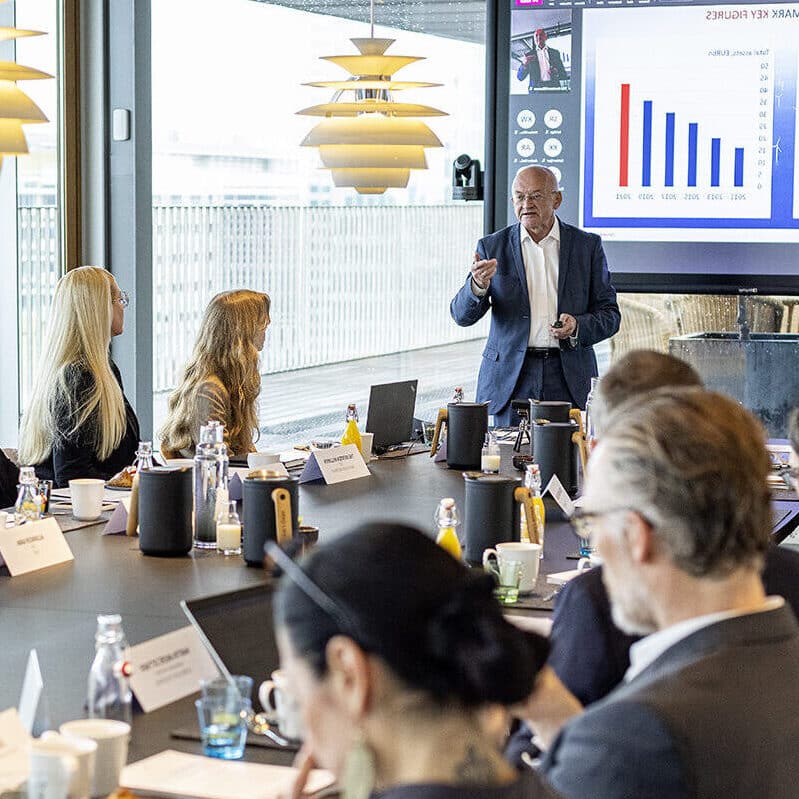The Diversity Council is a cross-industry alliance to accelerate the DE&I agenda
The Diversity Council provides a CEO and HR network through which large organisations can share and learn from best practice cases, and participate at the forefront of the societal DE&I conversation
DE&I is a vital lever in ensuring innovation, employee retention and profit. In the spirit of UN Global SDG #17 ‘Partnerships for the Goals’, the Diversity Council’s cross-industry alliance accelerates the progress to parity as companies can learn from each other’s successes and learnings, in a confidential forum, while ensuring a stronger collective voice in the public debate.
Vincent Clerc
CEO, A.P. Moller – Maersk A/S
Lars Thaaning Pedersen
Co-Founding Partner & Co-Chief Executive Officer, COP
Michael Hansen
Group President & CEO at Hempel
Eric Bernard
Group CEO, WSAudiology
Torsten Türling
President & CEO, Nilfisk
Vincent Clerc
CEO, A.P. Moller – Maersk A/S
”As a values driven company, we have in Maersk always had a strong focus on our People and the society around us. We truly believe, that as societies and businesses today it is paramount that we do not neglect the potential of diversity. For Maersk, it is not our physical assets that will make us successful in terms of serving our customers, facilitating global trade and helping societies create jobs and prosperity. It’s our people! Our engaged group of colleagues across the globe, working together as one diverse global team. Studies show that a diverse group makes better decisions faster – and therefore we believe it to be simply common sense for our leaders to look at the entire talent mass and ensure role models and incentives for all our employees.”
Lars Thaaning Pedersen
Co-Founding Partner & Co-Chief Executive Officer, COP
“As a young, fast-growing company operating in a rapidly expanding and global industry, COP considers it a business imperative to attract, develop, and retain a world-class workforce. We firmly believe that a culture embracing diversity, trust, and well-being at its core enables us to build teams representative of the local communities where we operate and will yield the best business results. Embracing and fostering diversity on all matters relevant to our company will give us the varied perspectives and solutions essential for our continued success.”
Michael Hansen
Group President & CEO at Hempel
“Here at Hempel, we are 7,500 colleagues dedicated to developing innovative and trailblazing coating solutions for our customers around the world. Innovative solutions that contribute to solving our customers’ most important challenges and, not least, creating a more sustainable future. To deliver on this ambition, it is paramount that we have a diverse group of colleagues with a vast variety of backgrounds, experiences, skills and knowledge. As an example, we have already made great strides in strengthening the opportunities for female colleagues, but much more still needs to be done. Our goal is to give every employee a fantastic place to work, one where they feel valued for being exactly who they are.
Joining the Diversity Council is a further commitment to our colleagues that we are invested to deliver on our DE&I promises. To have the opportunity to share our experiences on this journey and learn from other companies faced with similar opportunities and challenges is extremely valuable and one that we are happy to jump into feet first.”
Eric Bernard
Group CEO, WSAudiology
“We’ve heard it before: Diversity, equity and inclusion (DEI) boost innovation, retention, profitability, engagement and unleash the full potential of our people. While this is all true, for us at WSA it is more than just doing something right. DEI stems from our history, and is embedded in our values, products and not least our purpose of ensuring wonderful sound for all. By joining the Diversity Council, we are taking a stance on the importance of DEI for WSA, our customers and consumers and we are committed to continuously developing and learning in partnership with others.”
Torsten Türling
President & CEO, Nilfisk
“Creating a more sustainable future for the coming generations, we need to embed sustainability into everything we do. In Nilfisk this would not be possible without our dedicated people showing up every day with a growth mindset, also when it comes to diversity, equity, and inclusion. We have set a gender diversity milestone target of 25% women in senior management by 2026. In base year 2021, we had 14% women in senior management. In 2022, Nilfisk achieved an increase to 19% women in senior management and we are eager to make this development transcend the organization of our 4,700 colleagues across the world. This is a strong commitment from our side and why we want to join the Diversity Council to continuously get inspiration from other companies on this important agenda.”
The Diversity Council facilitates cross-industry knowledge-sharing through biannual CEO and HR meetings, centralised DE&I resources, PR and joint initiatives. These have included: research into the Danish Gender Equality Paradox, in collaboration with McKinsey & Company Denmark and a zero-tolerance statement regarding harassment.




